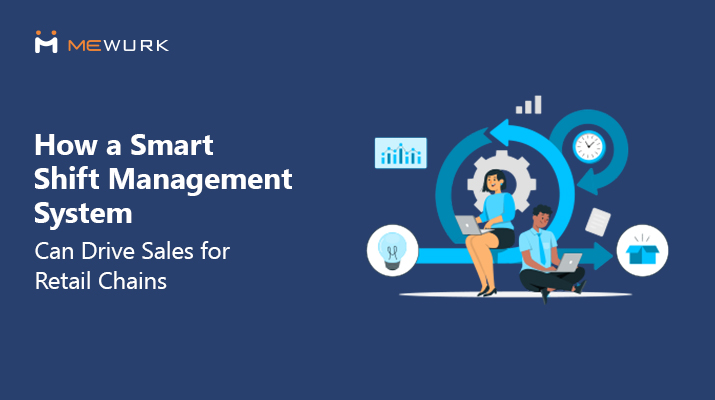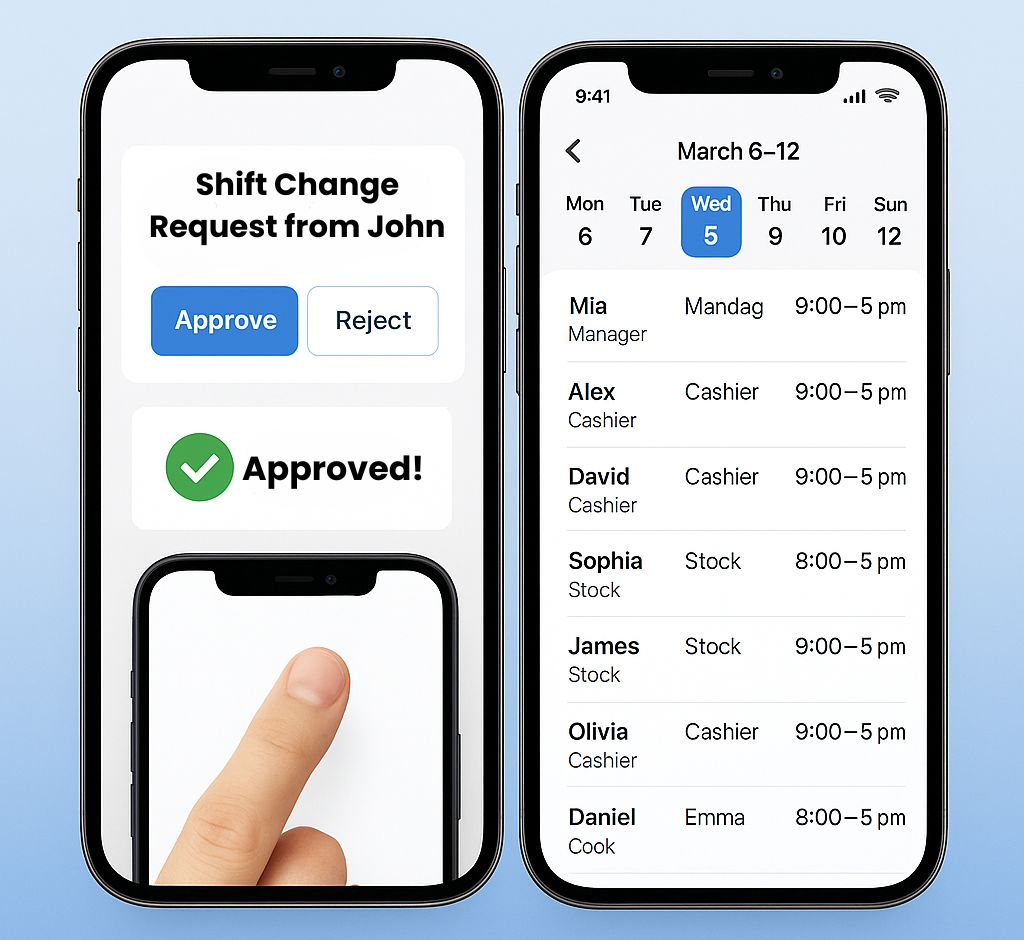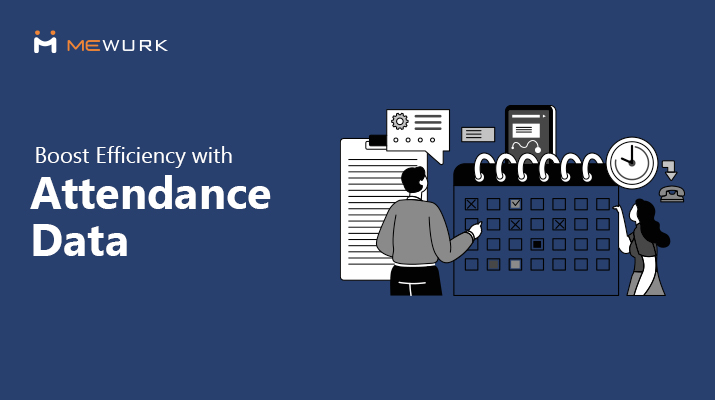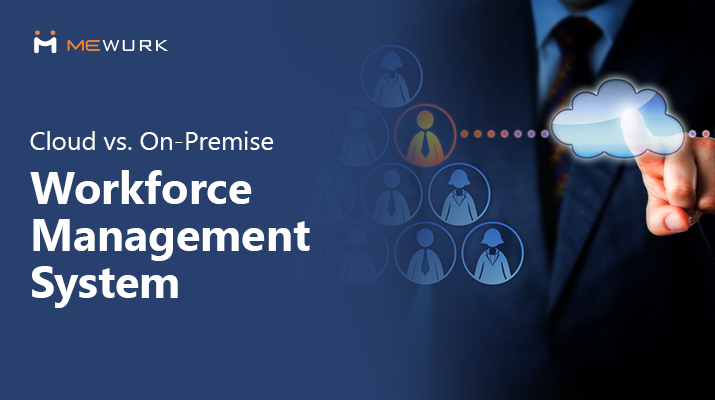
How a Smart Shift Management System Can Drive Sales for Retail Chains?
Did you know that 62% of retail managers report understaffing during peak shopping periods like weekends and holiday sales? And this costs them an estimated 14% loss in potential sales opportunities. It’s a costly issue, yet one that’s often overlooked.
The ecosystem of retail operations is quite complex. Among inventory management, customer service, merchandising, and marketing, shift management often remains relegated to a purely administrative function. With consumer demand fluctuating and markets in flux, retailers are being pushed to turn shift scheduling from a behind-the-scenes chore into a real-time sales advantage, which demands a smart shift management system. Let’s break down why a smart shift management system is needed in retail.
Retail Realities: How Employee Scheduling Affects Sales

In retail businesses, customer interactions with staff are crucial touchpoints. Imagine visiting a supermarket where you shop independently, but when you reach the checkout, there's no cashier to assist you. Or perhaps you need warranty information for a product, but can't find any staff to provide proper guidance. Poor shift coverage negatively impacts both sales and customer satisfaction.
A 2023 Zendesk study revealed that approximately 78% of customers consider their in-store service experience vital for maintaining brand loyalty. Likewise, a McKinsey report found that understaffing during peak hours can reduce daily store revenue by up to 20%. Put simply, disappointing experiences during store visits quickly erode customer loyalty. This underscores the importance of proper staffing and scheduling to ensure customers receive timely assistance throughout their shopping journey.
To keep customers happy and engaged, retailers must ensure there's always someone available to assist. They may need clarity about the pricing, products, or expect help with specific problems. Without it, loyalty fades fast.
Key Features of Employee Shift Management System for Retail Stores
Any retail store with more than a dozen employees is likely already using some form of digital tool for time and attendance tracking, as well as employee scheduling. While these systems usually handle the basics, they often fall short when it comes to the dynamic demands of retail.
A standard 9-to-6 compatible shift allocation system simply doesn’t suffice retail scenario since it requires flexible, intelligent shift management solutions that align with dynamic and demand-driven staffing needs. We’ve compiled here a list of essential features to look for in an ideal employee shift management system tailored for retail.
Demand-driven shift suggestions
An online shift scheduling software that can utilise the advanced capabilities of AI to analyse data collected from different sales venues, for instance, from POS (point-of-sale) and historical sales patterns, can be a real asset for retail businesses. By relying on such insights, businesses can predict customer footfall in advance and ensure optimal staffing levels so that they have the right number of employees when customers actually need them.
Auto shift-balancing across locations
The best shift management software for small businesses in retail should be capable of automatically distributing staff between multiple store locations based on real-time needs. When such a system is in place, understaffing at busy locations is minimised while excess personnel costs at quieter stores are effectively avoided.
Integrated absence handling + real-time alerts
Retail shops would greatly benefit from a smart staff shift rotation system where employees can report absences, while the software immediately alerts managers and suggests qualified replacements. This kind of proactive integration ensures coordinated operations and can effectively rule out any chances of scheduling gaps that lead to poor store coverage, without manual intervention.
Mobile-based instant approvals & live roster views

In an ideal online shift scheduling software, both the employees and managers should be able to view schedules, request changes, and approve shifts from anywhere on their desktops or mobile devices. The live roster updates in real-time will quickly display who's currently working and who can be depended on for last-minute needs.
Employee preferences + productivity analytics
Among the many benefits of using shift scheduling software, a noteworthy aspect is the system’s capability to track individual performance patterns and shift preferences to create schedules that reduce burnout. By analysing workload balance alongside preferences, it would assist in making schedules that employees find reasonably manageable and therefore minimise their absenteeism.
Real-World Impact in Retail Sector: Old vs. Smart Shift Management System (with Sales Metrics)
| Metric | Traditional Scheduling | Smart Shift Management System |
|---|---|---|
| Manual Time Spent on Roster | 6-8 hours/week | < 1 hour/week |
| Missed Shifts or Gaps | Frequent | Rare |
| Peak-Hour Staff Availability | Often Insufficient | Optimised based on traffic data |
| Customer Wait Times | 5–10 mins avg | <3 mins avg |
| Impact on Conversion Rates | -5% during poor staffing | +12–15% during optimised coverage |
Must-Have Integrations for Retail Shift Management System
Retail businesses employ diverse sales personnel operating across multiple environments - in-store associates, remote representatives, and field agents meeting prospects in settings like coffee shops. Ultimately, management prioritises conversion rates above all.
Adapting employee scheduling between remote and on-site work presents challenges that can be addressed through two primary approaches. First, implementing flexible shift planning solutions for remote teams allows for dynamic workforce allocation. Second, integrating shift management systems with complementary business tools such as payroll processors, point-of-sale systems, and other productivity platforms creates a cohesive operational framework.
Let's examine these approaches within the context of optimising retail sales team performance and conversion metrics.
POS System Integration
Workforce planning can be extraordinarily enhanced by connecting the shift management system with point-of-sale (POS) data. Leveraging POS insights allows for demand-driven scheduling, such as:
- Placing top performers during high-traffic periods
- Making scheduling decisions based on real-time conversion metrics
- Tracking staff performance through sales-per-hour analysis
Payroll Sync (Incentivise Peak Hour Work)
It is essential for retail businesses to stay equipped with tools to manage rotating work shifts efficiently, while automatically applying differential pay rates for challenging shifts. When those employees who work complex shifts get rewarded a little extra, management need not worry about coverage issues as these incentives ensure adequate staffing during difficult periods. Some ideal benefits of such an integration would include:
- Automatically apply higher pay rates for peak or hard-to-fill shifts
- Reward employees with bonuses based on actual shift performance
- Let staff track their earnings in real-time.
Biometric or Facial Recognition-Based Attendance

While ensuring seamless shift planning, if you want to restrict workplace entry to only scheduled staff and keep unauthorised people out, it's best to use online scheduling software that connects with biometric facial recognition attendance systems. These advanced systems:
- Verify who belongs where
- Maintains tight security across multiple locations
- Eliminate opportunities for time theft (buddy-punching/fraudulent time reporting)
- Accelerates start-of-shift transitions
- Provides precise data for performance analysis
Cloud Sync for Multi-Location Transparency

If you're wondering how to automate employee shift scheduling for teams working across multiple locations, the answer lies in a cloud-based shift management system. These modern solutions enable automation through a centralised database that:
- Guarantees real-time staffing visibility across all locations
- Facilitates rapid staff redeployment when needed
- Identifies cross-training opportunities between environments
In a Nutshell
There’s no doubt that shift management systems are recognised as essential operational tools across all industries. But in the context of sales, you need to think of it as something more. A precision tool that sharpens your sales weapon.
Is your online shift scheduling software helping you drive better sales outcomes? We appreciate your thoughts. Share them in the comments below!
If not, maybe it’s time to give Mewurk’s employee shift management system a try. It could be just what your sales team needs to stay sharp and ready.
Most Popular Post

Why Accurate Attendance and Leave Management Matters for Business Growth?
Read More →Why Accurate Attendance and Leave Management Matters for Business Growth?
How To Leverage Attendance Data For Better Workforce Management?
Read More →How To Leverage Attendance Data For Better Workforce Management?




